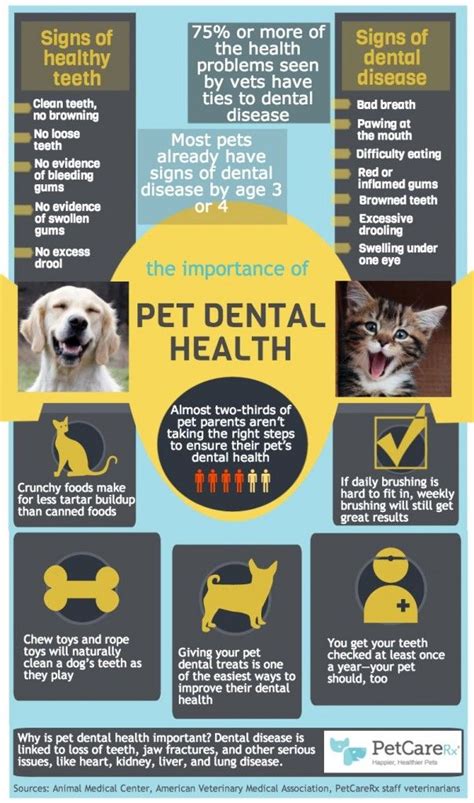Pet dental care is crucial for the overall health and well-being of our furry companions. Neglecting dental hygiene can lead to a host of problems that can affect their comfort, appetite, and overall lifespan. This comprehensive guide will provide pet owners with the essential knowledge and tips to ensure their pets maintain optimal oral health for years to come.

1. The Importance of Pet Dental Care
- Prevents Bad Breath: Dental disease is a major culprit of bad breath in pets. Regular dental care removes plaque and bacteria that cause unpleasant odors.
- Protects Against Diseases: Poor dental hygiene increases the risk of dental infections, which can spread to the bloodstream and cause severe health issues.
- Relieves Pain and Discomfort: Dental disease can cause severe pain and discomfort, affecting pets’ eating habits and overall quality of life.
- Improves Overall Health: Healthy teeth contribute to a healthy digestive system, immune system, and cardiovascular system.
2. Common Dental Problems in Pets
According to the American Veterinary Medical Association (AVMA), dental disease is the most common health issue in cats and dogs over three years old. Some common dental problems include:
- Periodontal Disease: Inflammation and infection of the tissues supporting the teeth.
- Gingivitis: Inflammation of the gums.
- Tooth Decay: Damage to the tooth structure caused by bacteria.
- Abscessed Teeth: Pus-filled infections within the tooth.
- Dental Tumors: Abnormal growths in the mouth.
3. Signs of Dental Problems
Early detection is key to preventing serious dental issues. Here are some signs that may indicate your pet needs dental attention:
- Bad breath (halitosis)
- Bleeding or swollen gums
- Plaque or tartar buildup
- Loose or missing teeth
- Changes in eating habits
- Drooling or pawing at the mouth
4. Pet Dental Care Routine
Maintaining a regular dental care routine is essential for optimal pet oral health:
- Brush Your Pet’s Teeth: Brush your pet’s teeth at least twice a week using a pet-specific toothpaste and toothbrush.
- Provide Dental Chews: Dental chews can help remove plaque and massage the gums. Choose chews approved by the Veterinary Oral Health Council (VOHC).
- Feed a Dental Diet: Some pet foods are formulated to promote dental health by reducing plaque and tartar buildup.
- Visit the Vet Regularly: Schedule regular dental checkups and professional cleanings with your veterinarian.
5. Dental Treatment Options
If your pet develops dental problems, your veterinarian may recommend various treatment options:
- Dental Cleaning: A professional cleaning involves removing plaque, tartar, and bacteria from the teeth.
- Tooth Extraction: If a tooth is severely decayed or infected, it may need to be extracted.
- Root Canal: A root canal can be performed to save a tooth with a damaged root.
- Dental Surgery: More complex dental issues may require specialized surgical procedures.
6. Prevention and Common Mistakes to Avoid
- Avoid Sugary Treats: Sugary snacks can promote tooth decay in pets.
- Don’t Share Your Food: Human foods often contain ingredients that can be harmful to pets’ teeth.
- Don’t Overbrush: Excessive brushing can damage your pet’s gums.
- Ignore Bleeding Gums: Even slight bleeding should be addressed promptly by a veterinarian.
- Delay Dental Cleanings: Regular dental cleanings are crucial for preventing dental disease.
7. Pet Dental Care Cost
The cost of pet dental care varies depending on the type of treatment required. Here are some average costs:
| Type of Treatment | Cost Range |
|---|---|
| Dental Cleaning | $150-$400 |
| Tooth Extraction | $150-$500 |
| Root Canal | $400-$1,000 |
| Dental Surgery | $1,000-$3,000 |
8. Dental Insurance for Pets
Pet dental insurance can help cover the cost of dental care, including preventive and major treatments. Consider pet dental insurance to protect your pet’s oral health and save money on unexpected expenses.
9. Conclusion
Pet dental care and hygiene are essential for the long-term health and well-being of our furry friends. By following a proper dental care routine, monitoring for signs of problems, and seeking professional veterinary care when necessary, pet owners can help their pets maintain healthy mouths and enjoy a lifetime of smiles.
Appendix
Table 1: Dental Disease Statistics
| Statistic | Source |
|---|---|
| 80% of dogs and 70% of cats have some form of dental disease by age 3. | AVMA |
| Dental disease is the most common health issue in pets over 3 years old. | AVMA |
| Bad breath (halitosis) affects an estimated 85% of dogs and 70% of cats over 3 years old. | VOHC |
Table 2: Recommended Dental Care Frequency
| Pet Type | Brushing Frequency | Dental Chews | Dental Diet | Vet Visits |
|---|---|---|---|---|
| Dogs | Twice a week | Daily | Optional | Once a year |
| Cats | Once a week | Several times a week | Optional | Twice a year |
Table 3: Dental Chews Approved by VOHC
| Brand | Product Name |
|---|---|
| Greenies | Original Dental Chews |
| Pedigree | Dentastix |
| Purina | ProPlan Veterinary Diets Dental Chews |
| Virbac | CET Veggiedent Chews |
| Hill’s | Science Diet Oral Care Chews |
Table 4: Pet Dental Insurance Providers
| Provider | Coverage | Annual Premium Range |
|---|---|---|
| Trupanion | Unlimited dental coverage | $200-$900 |
| Embrace | Up to $1,000 annual coverage | $150-$600 |
| Fetch | Up to $2,000 annual coverage | $175-$700 |
| Healthy Paws | Up to $2,500 annual coverage | $200-$800 |





















